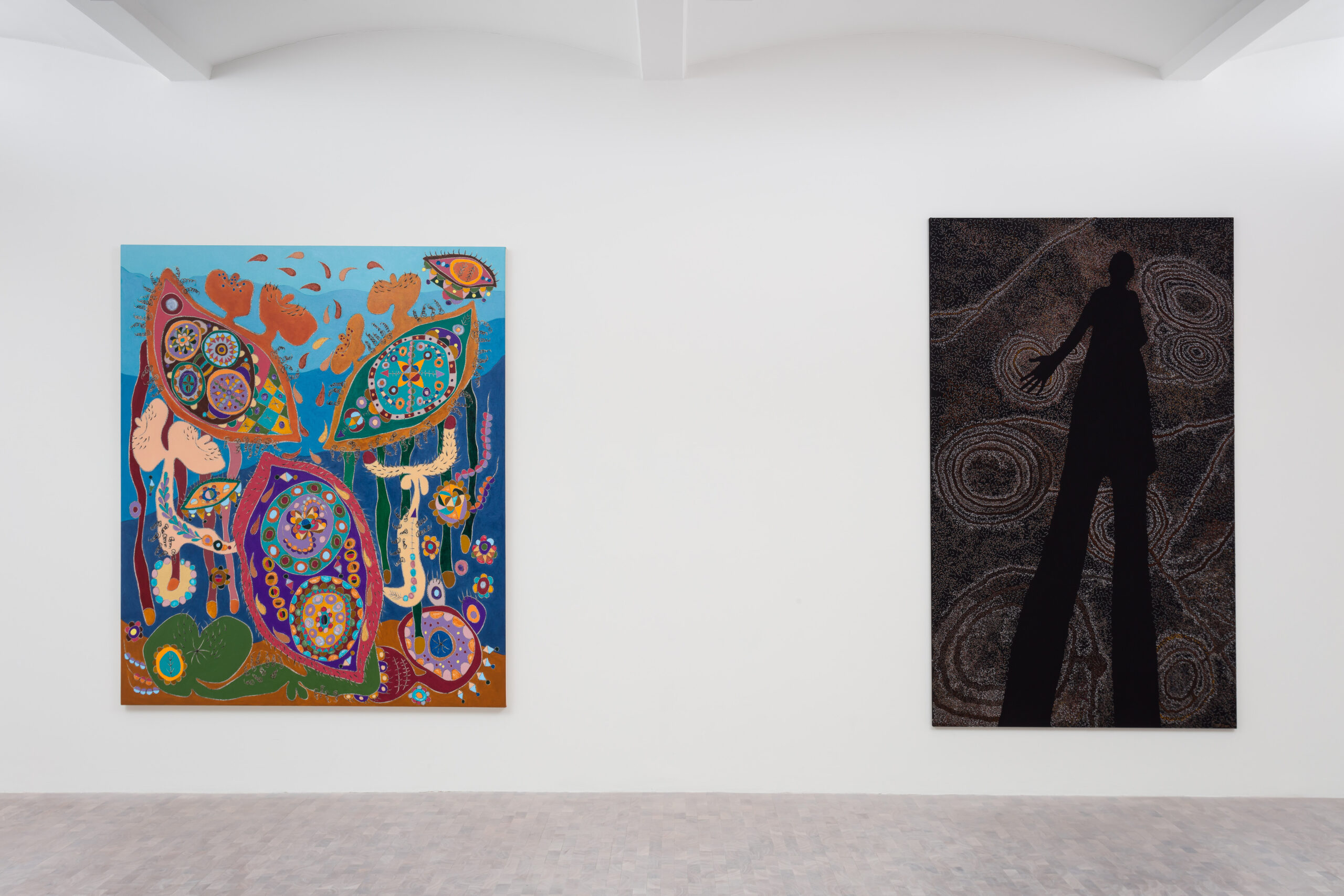


Merikokeb Berhanu · Nasim Hantehzadeh · Isaac Julien · Abdoulaye Konaté · Tamar Mason · José Vera Matos · Alyina Zaidi
Dispatch: 13/05
Where cloudy waters collide...
Pippy Houldsworth Gallery, Mayfair
6 May - 4 June 2022
Where cloudy waters collide… at Pippy Houldsworth Gallery explores humanity’s connection to place, history, and nature.
The group exhibition features seven artists of different generations and backgrounds, who reflect on cultural identity and belonging when living between cultures and across borders in today’s post-colonial world that is shaped by global migration.
Each artist in the show explores inter-cultural exchanges, subverting empirical cartographies and the idea of fixed cultural identities by mapping the spaces ‘in-between’, such as notions of the body and the mind, the mythological and the ritualistic, the ‘illicit’ and the invisible.
Isaac Julien’s photographic series Paradise Omeros, 2002, which is loosely based on Derek Walcott’s poem Omeros, explores the socio-political landscape of people of the Caribbean diaspora. The exhibition presents photographic works Julien took during the making of his film Paradise Omeros in St. Lucia in 2002 (recently on display in the exhibition ‘Life Between Islands – Caribbean-British Art 1950s - Now’ at Tate Britain). Paradise Omeros uses the metaphor of the sea as a space for cross-cultural exchange highlighting the hybrid mental states and feelings of creolisation that accompany a life that is rooted in multiple cultures.
This cultural fluidity is also reminiscent in Nasim Hantehzadeh’s large colourful oil painting The weight on my shoulders, 2022. Contemplating the experience of returning to the United States – her country of birth – after being raised in Iran until early adulthood, Hantehzadeh creates visually powerful narratives around identity, race and gender. By integrating forms reminiscent of sexual organs and dispersing them amongst one another, her hybrid figures can be seen as a comment on her own experience of emigration.
Situated between the conscious and the subconscious, Merikokeb Berhanu’spaintings are not about a specific time and place. The exhibition presents two works made both prior and after her relocation from Ethiopia to the United States in 2017. Capturing the feelings of her varied experiences of living in these two distinct countries, Berhanu, who was trained by an elite group of Modernist artists in Ethiopia, creates sophisticated abstract paintings, hinting at the tension between nature and urbanity and how this dichotomy feeds into her own experience of traversing cultures.
One of the most important artists of his generation, Malian artist Abdoulaye Konaté’s vibrantly layered large wall textiles meld small pieces of dyed cotton fabrics from Mali together to form large and richly detailed canvases. Le papillon jaune, 2016, presented next to one of Berhanu’s paintings, uses the fragility of the butterfly to comment on West Africa’s instable socio-political structure and to balance global politics with his own rich local and cultural history.
Peruvian artist José Vera Matos questions essentialist and single-rooted visions of cultural identities. For his pastel-coloured series A World in Relation, 2020 the artist meticulously transcribed French-Martiniquian writer Édouard Glissant’s influential book The Poetics of Relation (1990) into carefully composed syntactic structures on bamboo paper, mimicking the layout of island masses or organic forms. In his complex compositions Matos explores the formal rigidity of the text, now reconfigured as roots or rhizomes that are seeking cross-societal connections.
Alyina Zaidi's work is grounded in her own experiences of growing up in Kashmir. The ethereal dreamscapes of her richly coloured canvases refer to her cross-cultural background, her memories, and the environments that have shaped her. The fluctuation that permeates her painted scenes highlights a more fluid form of cartography, integrating multiple perspectives.
Drawing inspiration from her country of birth, Tamar Mason’s practice speaks about the complex geography and history of South Africa. Her recent embroidery and beadwork on fabric canvases, like Mashishing, 2022 and Gxara, 2020 depict silhouetted elongated figures, foregrounding spherical forms that allude to the celestial. Focusing on neglected rural areas in South Africa, Mason’s oeuvre reflects on personal experiences, the landscape and the legacies of colonialism.
Where cloudy waters collide…is a poignant and original selection of work by artists of multiple cultural backgrounds and generations. It acts as a strong reminder that our identities are not fixed but continuously shifting. To me all the artists in the exhibition powerfully visualise what cultural theorist Homi K. Bhabha described as the ‘third space - a utopian space, where cultural differences are successfully negotiated, Eurocentric perspectives eliminated, borders opened - a space in-between that can give rise to new meanings and forms.
Christine Takengny
Senior Curator
Image Credit: Installation view of Where cloudy waters collide... Courtesy Pippy Houldsworth Gallery. Photo Credit: Mark Blower
Pippy Houldsworth Gallery, 6 Heddon Street, London, W1B 4BT
Opening Times: Tuesday - Friday 10am - 6pm. Saturday 11am - 6pm
Exhibition open until 4 June